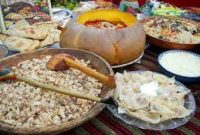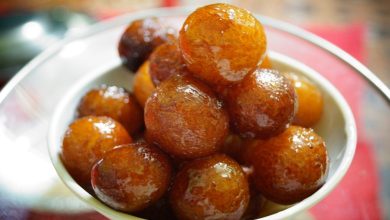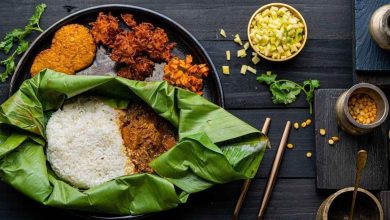Introduction:
Known as the “Crossroads of Cultures,” Central Asia is a place where many nationalities, history, and landscapes come together. The diverse range of tastes, cooking methods, and culinary customs found in Central Asian cuisine are a fascinating reflection of this complex tapestry of civilizations. This essay takes readers on a gourmet tour throughout Central Asia, highlighting the top dishes that embody the region’s distinctive culinary culture.
1. Plov: The Heart of Central Asian Cuisine
The foundation of the cuisine of Central Asia is plov, a dish that is commonly consumed there. Variously referred to as pilaf or pulao, this meal is a wonderful blend of rice, meat (often lamb or beef), carrots, and a harmonious blend of spices. Every country adds its own special touch to the cooking techniques and particular ingredients used. Plov is a specialty of Uzbekistan, which takes pleasure in producing this meal with great attention to detail, resulting in a delicious masterpiece that captures the spirit of Central Asian hospitality.
2. Lagman: Noodles of Harmony
Lagman is a noodle dish that has its roots in Central Asia and is a reflection of the region’s many influences. Handmade noodles, veggies, and meat—typically lamb or beef—are usually served in this meal with a flavorful broth enhanced with fragrant spices. Lagman’s distinct tastes and interplay of textures make it a popular culinary dish. Variations appear as it moves across Central Asian countries, from Kyrgyzstan to Kazakhstan, demonstrating the versatility and inventiveness inherent in the cuisine.
3. Manti: Pillows of Delight
Manti are delicious dumplings filled with minced meat (usually lamb or beef) and sometimes served with pumpkin or onions. They are highly prized in Central Asia as a culinary treasure. These meat-loving dumplings, which may be boiled or steam-cooked, are a tasty and easy way to celebrate the nomadic tradition of the area. Manti can be found in various Central Asian countries, each adding its unique twist to this beloved dish, whether in the form of distinctive seasonings, sizes, or shapes.

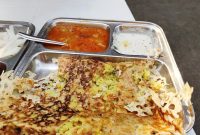
4. Shashlik: Central Asian Barbecue Mastery
Skewered and grilled beef, or “shashlik,” is a dish that is traditionally served during outdoor parties in Central Asia. Tasty marinating of meat, usually lamb or beef, in a mixture of spices and herbs gives the skewers a unique flavor. Shashilik captures the essence of Central Asian cuisines and communal dining, whether it is consumed at a family event in Turkmenistan or in the busy bazaars of Tajikistan.
5. Samsa: Flaky Delights of Central Asia
A popular snack in Central Asia is the samsa, a pastry stuffed with delicious ingredients such minced meat, onions, and spices. Flaky layers of dough encase a rush of flavors, which is why they’re a popular option for a filling and speedy nibble. Samsa, which may be found in Kyrgyzstan, Uzbekistan, and other countries, demonstrates the common culinary history that unites the varied countries of Central Asia.
6. Chak-Chak: A Sweet Symphony
Chak-Chak is a delicious delicacy that is enjoyed all across Central Asia and is considered a culinary marvel. This cuisine, which consists of honey-coated deep-fried dough balls, is influenced by Central Asian nomadic customs. In Kazakhstan, Uzbekistan, and other Central Asian countries, chak-chak is a symbol of festivities and hospitality due to its complex preparation and delightful indulgence.
7. Central Asian Tea Culture: A Ritual of Connection
The tradition of tea in Central Asia is more than simply the drink; it is a social and welcoming ritual. Tea is served with a selection of candies, nuts, and dried fruits and is frequently presented in elaborate samovars. Tea-drinking and tea-making are deeply ingrained traditions that promote coziness and camaraderie. The many countries of Central Asia are united by their shared tea tradition.
Conclusion: A Culinary Mosaic
In conclusion, the history, geography, and cultural variety of the area are all reflected in the enthralling mosaic that is Central Asian food. Every item in the menu, from the robust plov to the delicate layers of samsa, relates a tale of Central Asian cultures’ tenacity, cultural exchanges, and nomadic customs. The smell of spices filling family kitchens and busy bazaars, drawing together and captivating those who are lucky enough to indulge in this culinary adventure are Central Asia’s culinary riches.

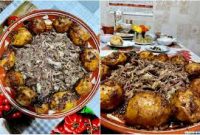
In summary, the historical, geographical and cultural diversity of the region is reflected in a fascinating mosaic of Central Asian cuisine. From rich plov to delicately layered samsa, each menu item speaks to the tenacity, cultural exchange, and nomadic customs of Central Asian culture. The aroma of spices that fills home kitchens and bustling bazaars, drawing in those lucky enough to indulge in this culinary adventure, is the culinary treasure of Central Asia.
